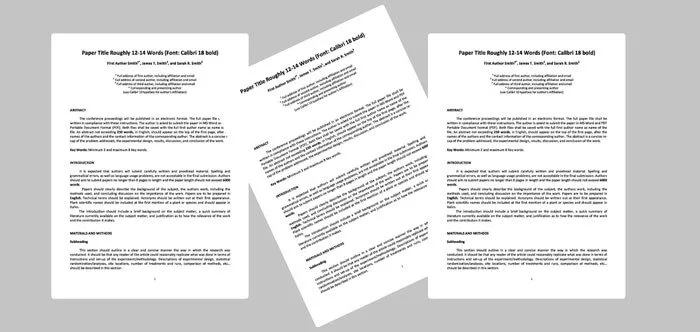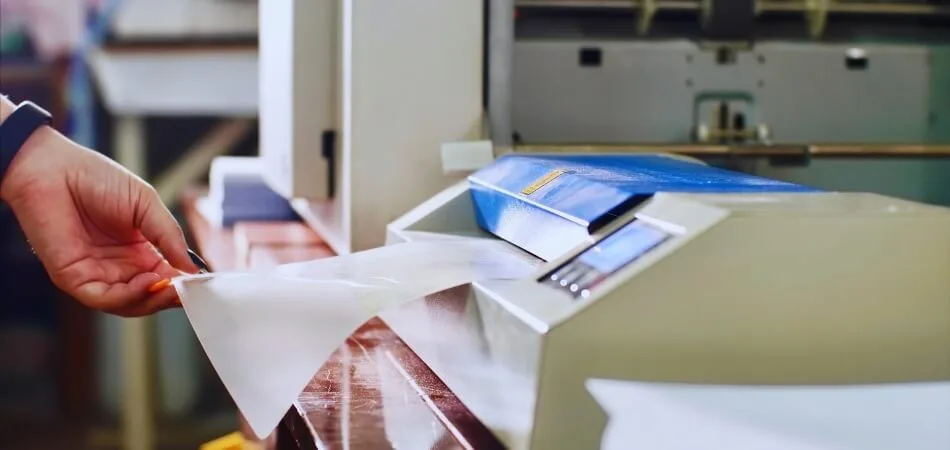Conference posters are essential tools for researchers and professionals to showcase their work. They serve as a visual representation of complex ideas, designed to engage and inform viewers. One common question that arises is, “Should I laminate my conference poster?”
Yes, you should consider laminating your poster to increase its durability and give it a more professional appearance. However, you should be aware that lamination adds weight and can cause glare under certain lighting conditions.
Factors like ease of transport and the possibility of reusing the poster should also play a role in your decision. To explore deeper into the pros and cons of laminating your conference poster, keep reading as we explore this topic further in the article.
A Brief Overview of a Conference Poster
A conference poster is a visual presentation of research findings or projects displayed at academic conferences. Typically, it includes key information such as the title, authors, abstract, methodology, results, and conclusions.
Conference posters serve as a concise and engaging way for researchers to communicate their work to peers and potential collaborators. They are often displayed during poster sessions, allowing for informal discussions and networking opportunities.
A conference poster, designed by a professional conference organizer, is a succinct visual representation of research findings or projects showcased at academic gatherings. Whether presented at international events or specialized conferences in Canada, these posters encompass essential details like title, authors, abstract, methodology, results, and conclusions.
These posters serve as dynamic tools for researchers to disseminate their work to peers and potential collaborators. Typically featured in poster sessions, they facilitate informal discussions and networking opportunities among attendees.
Importance of Preserving Conference Poster
Conference posters are a vital tool in the academic and professional world, serving as a visual summary of research or projects. They are a common feature at academic conferences and seminars, offering a concise and engaging way to present complex information. Here’s why preserving them is crucial:
- Preserving conference posters allows for a historical record of research progress and trends over time. It provides an archive that future researchers and students can reference and learn from.
- These posters often represent significant personal and institutional achievements. Safeguarding them acknowledges and honors the hard work and creativity involved.
- Conference posters can be reused in educational settings, offering a visual aid to enhance learning and discussion. Their preservation ensures that valuable resources remain accessible for teaching purposes.
- By keeping these posters, we maintain a tangible connection to past events and ideas. They act as a bridge linking current research to its historical roots.
- Preserving conference posters also allows for a wider dissemination of knowledge. They can be displayed in various settings, reaching audiences beyond the original conference attendees.
- Conference posters with innovative designs often feature creative data visualization techniques. Keeping them can inspire future presentations and methods of conveying complex information.
The importance of preserving conference posters extends beyond mere record-keeping. It’s about valuing the essence of academic and professional contributions, ensuring that the knowledge and creativity they embody continue to inspire and educate future generations.
Should I Laminate My Conference Poster?
Yes, laminating your conference poster can be a wise choice, particularly if you seek durability and a professional finish. Lamination protects your poster from wear and tear, making it more resilient during presentations and transportation. However, it’s not a one-size-fits-all decision, and various factors come into play.
Durability and Protection
Laminating your poster significantly increases its durability, making it resistant to physical damage, moisture, and dirt. This is particularly beneficial in bustling conference settings where posters can be susceptible to wear. Additionally, a laminated poster can withstand multiple uses, ideal for those who intend to present their work at several events.
Professional Appearance
A laminated poster often looks more professional and polished. This can be crucial in creating a strong first impression, as it reflects the quality and seriousness of your work. The lamination adds a sleek finish, enhancing the colors and clarity of your poster’s graphics and text.
Weight and Portability
While lamination adds a protective layer, it also increases the weight and inflexibility of your poster. This might pose challenges in terms of transportation, especially for those traveling to conferences by plane or public transport. Consider the logistics of carrying a laminated poster to your destination.
Glare and Visibility
One downside of lamination is the potential for glare, which can hinder the readability of your poster in certain lighting conditions. This is an important consideration if your poster contains detailed graphs or images that need to be visible from a distance.
Cost and Accessibility
Consider the cost and availability of lamination services. Laminating a large poster can be expensive and not all print shops offer this service. Balance the benefits of lamination against your budget and the availability of services in your area.
Future Use and Reusability
If you plan to reuse your poster for future conferences or as an educational tool, lamination is a wise choice. It preserves the quality of the poster over time, making it a reusable resource for various occasions.
While laminating your conference poster offers several benefits, consider these factors to determine if they align with your specific needs and circumstances. Make an informed decision that enhances the presentation and longevity of your work.
Alternative Methods of Preserving Conference Posters
Conference posters are not just academic presentations; they’re a testament to hard work and innovation. To ensure these valuable documents stand the test of time, preservation is key. While lamination is a common method, there are other effective alternatives to consider.
Use of High-Quality Materials
Start by printing your poster on high-quality, durable paper. Thick, acid-free paper resists degradation over time. This material is less prone to tearing and can withstand handling better than standard paper. Opting for archival-quality paper ensures your poster remains intact and vibrant for years.
Protective Sleeves and Tubes
Storing your poster in a protective sleeve or tube can prevent damage. Clear plastic sleeves offer protection against dust and moisture, keeping the poster clean. Cardboard tubes are ideal for transportation, safeguarding the poster from creases and folds. Ensure the materials used are acid-free to avoid long-term damage.
Proper Handling and Display
Handling your poster with care extends its lifespan. Always hold it by the edges to avoid fingerprints and smudges. When displaying, avoid direct sunlight or damp areas, as these can fade or damage the poster. After use, carefully roll or lay it flat in a safe, dry place.
Digital Preservation
Creating a high-resolution digital copy of your poster ensures its longevity. Digitally archiving your work offers a backup in case the physical copy is lost or damaged. This method also allows easy sharing and reproduction if needed. Regular backups and using reliable storage mediums are essential.
Framing for Display
If you intend to display your poster, consider framing it. A frame provides solid protection and can enhance the poster’s appearance. Use UV-resistant glass to prevent fading from light exposure. Ensure the frame is sealed well to keep out dust and moisture.
Preserving conference posters is crucial for maintaining the integrity of your academic and professional work. Whether through the use of quality materials, protective storage, careful handling, digital archiving, or framing, each method offers its benefits. Choose the right approach based on your poster’s needs and your personal preferences.
Consideration Before Laminating Your Conference Paper
Laminating a conference paper is a significant decision that can impact its usability and presentation. It’s a process that involves encasing the paper in a protective plastic film. Before proceeding, it’s important to weigh several key considerations.
- Purpose and Frequency of Use: Consider how often you’ll use the paper. Frequent handling necessitates durability, making lamination a practical choice.
- Transport and Storage: Laminated papers are stiffer and might be challenging to transport or store. Think about how you’ll carry and keep your paper.
- Cost Implications: Lamination adds extra cost. Assess if the benefits of laminating justify the additional expenditure for your specific situation.
- Future Modifications: Once laminated, making changes or annotations on the paper becomes difficult. Ensure your content is final before laminating.
- Visual Impact and Readability: Lamination can cause glare, potentially affecting the paper’s readability under certain lighting. Consider the typical viewing conditions.
- Environmental Factors: Lamination involves plastic, which might not be eco-friendly. Reflect on the environmental impact of using plastic materials.
Laminating your conference paper should be a carefully considered decision, taking into account factors like usage, cost, and environmental impact. Choose wisely to ensure your paper serves its intended purpose effectively.
Pros and Cons of Laminating Conference Posters
Professionals and scholars who want to improve the look and longevity of their presentation materials might consider laminating their conference posters. While this process offers several benefits, it also comes with certain drawbacks. Here’s a more detailed look at the pros and cons.
Pros
- Enhanced Durability: Laminating a poster provides robust protection against tears, spills, and creases, significantly prolonging its lifespan even in high-traffic areas.
- Professional Look: A laminated poster has a sleek, glossy finish, which gives it a more refined and professional appearance, suitable for academic and business settings.
- Long-Term Preservation: Laminated materials resist fading and aging better than non-laminated counterparts, ensuring the poster remains in good condition for future displays or references.
- Easier to Clean: The smooth surface of a laminated poster allows for easy cleaning of dirt and smudges, maintaining a neat and presentable appearance throughout the event.
- Resistance to Weather Elements: Lamination offers protection against moisture and humidity, making it ideal for use in outdoor settings or humid conference environments.
Cons
- Added Weight and Rigidity: The lamination process adds weight and makes the poster less flexible, potentially complicating transportation and storage, especially for larger posters.
- Potential for Glare: The glossy finish of laminated posters can create a glare under certain lighting conditions, potentially hindering readability and audience engagement.
- Irreversibility and Cost: Once a poster is laminated, it cannot be edited or changed, limiting flexibility; additionally, the process incurs extra costs, which might be a consideration for those with limited budgets.
Laminating a conference poster can greatly enhance its longevity and visual appeal, but it’s important to consider the practical implications like weight, glare, and cost. Carefully weighing these pros and cons will help you make an informed decision that suits your specific needs and presentation goals.
Conclusion
The decision of whether to laminate your conference poster hinges on a careful evaluation of your specific needs and circumstances. Should I laminate my conference poster? is a question that should be answered by considering factors like the poster’s intended use, the importance of durability and professionalism, as well as practical considerations such as weight and cost.
While lamination offers enhanced protection and a polished appearance, it’s not without its drawbacks, including the potential for glare and added inflexibility. Furthermore, alternative preservation methods like using high-quality materials, protective sleeves, digital archiving, or framing provide viable options to safeguard your valuable presentation materials.
Ultimately, your choice should align with your goals and priorities to ensure a successful and impactful presentation.








